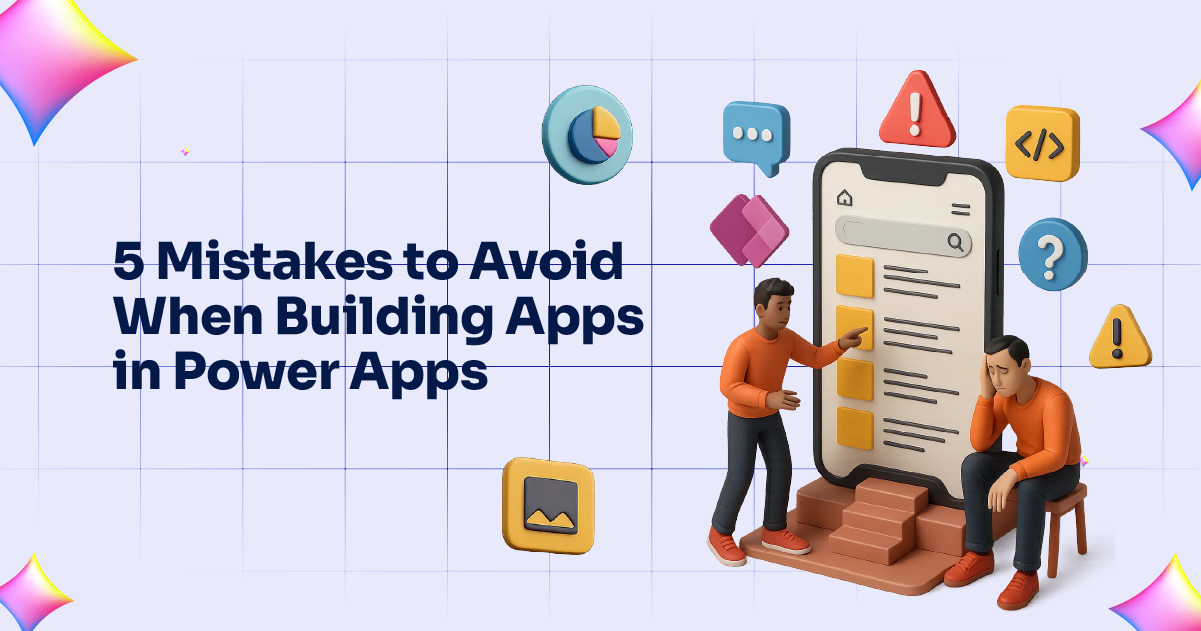
In today’s fast-paced business world, the need for customized applications to address specific business needs is growing rapidly. Microsoft Power Apps provides a low-code platform that enables users to create custom apps without deep programming knowledge. However, while Power Apps is a powerful tool, it’s not immune to mistakes, especially when it comes to app development.
Whether you’re a beginner or an experienced user, knowing common pitfalls and how to avoid them can help ensure a smoother app-building experience. In this blog, we’ll discuss 5 common mistakes that developers often make when building apps in Microsoft Power Apps and how you can avoid them.
1. Overlooking the Importance of App Design and User Experience (UX)
One of the biggest mistakes you can make when building an app in Microsoft Power Apps is neglecting the design and user experience (UX). Power Apps makes it easy to build apps, but if the user interface is cluttered, difficult to navigate, or not visually appealing, your app may fail to meet user expectations.
To avoid this mistake, take time to consider your app’s design from the perspective of the end user. Start with wireframes or prototypes to sketch out the user flow. Make sure your app is simple, intuitive, and consistent with your brand’s style guide. Think about the layout, color scheme, and accessibility features. A clean, organized app will improve adoption rates and user satisfaction.
2. Failing to Plan for Scalability
When you build an app, it’s easy to focus on immediate needs and overlook the long-term growth of your app. But if your app is built without considering scalability, you might run into issues as your app usage increases or if your business processes evolve.
Scaling issues often arise when developers don’t account for how the app will perform as data or traffic increases. For example, using inefficient formulas or creating complex business logic without optimizing for performance can cause the app to slow down.
To avoid scalability issues, it’s important to plan for growth from the start. Think about how your app will handle increased data loads and how it can evolve as your business needs change. Optimize your app’s performance by using delegation where possible, and keep data sets lean by avoiding unnecessary complexities in your formulas and app logic.
For businesses looking for professional guidance on scaling their apps or implementing Microsoft tools effectively, Microsoft Power Apps offers valuable resources and services to ensure you get the best performance for your apps.
3. Not Integrating with Other Microsoft Products Effectively
Power Apps integrates seamlessly with other Microsoft tools like SharePoint, Dynamics 365, and Excel, but failing to leverage these integrations is a common mistake. These integrations provide a unified experience that can streamline data sharing, reporting, and workflows.
For example, if you need to create an app that pulls data from a SharePoint list, not using the proper connectors or failing to configure the integration correctly can lead to errors, data duplication, and inefficient workflows.
To avoid this mistake, make sure to fully explore Power Apps’ integration capabilities. Integrate your app with the relevant Microsoft tools and configure them correctly. Additionally, test your integrations thoroughly to ensure seamless communication between the apps and data sources.
4. Overcomplicating the App’s Functionality
While Microsoft Power Apps provides a wide range of functionalities, it’s tempting to overcomplicate your app with too many features or overly complex logic. The beauty of Power Apps lies in its simplicity and low-code approach, so introducing unnecessary complexity can cause performance issues and confuse the users.
Overcomplicating the app may include adding too many screens, using convoluted formulas, or introducing unnecessary features that aren’t aligned with the app’s primary objective. This not only increases the risk of bugs but also makes the app harder to maintain.
To avoid this, focus on the core functionality that your app needs to deliver. Start with a simple version of the app and iterate as needed. Always consider whether a feature or logic is truly necessary and whether it adds value to the end user. The simpler the app, the easier it will be to maintain and scale over time.
5. Neglecting Security and Data Privacy
Security should be a top priority when building apps in Microsoft Power Apps, especially when dealing with sensitive data. Power Apps offers built-in security features such as role-based access control (RBAC) and integration with Azure Active Directory (AAD), but many developers fail to configure these features properly or neglect security altogether.
For instance, failing to set appropriate user permissions or not using secure connectors can leave your app vulnerable to unauthorized access or data breaches. Similarly, failing to comply with data privacy regulations such as GDPR can lead to legal issues and reputational damage.
To avoid these risks, prioritize security from the very beginning. Set up role-based permissions to control who has access to certain data and app features. Regularly audit your app’s security settings and ensure it complies with relevant data privacy regulations. By doing so, you can protect your users’ sensitive information and ensure that your app meets compliance requirements.
Conclusion
Building apps in Microsoft Power Apps is an excellent way to address unique business challenges, but it comes with its own set of pitfalls. By avoiding these common mistakes — from overlooking design to neglecting security — you can create a more efficient, scalable, and secure app.
If you need further assistance with Microsoft Power Apps or want to enhance your organization’s productivity with seamless integration across Microsoft products, consider seeking out expert services in Microsoft Power Apps. By partnering with professionals, you can make the most of the platform’s capabilities and avoid costly mistakes along the way.
Building an app isn’t just about making it work — it’s about making it work well. So, take the time to plan, design, and integrate your app properly, and you’ll have a tool that drives success for your business.
